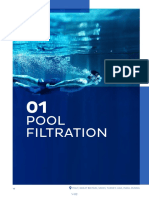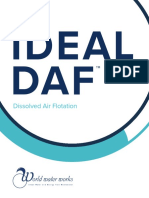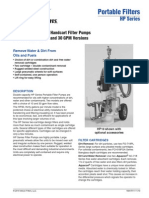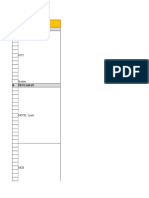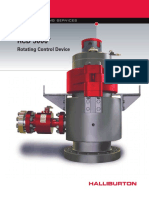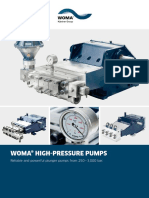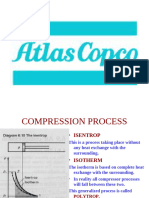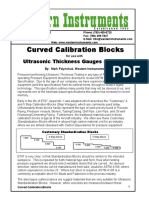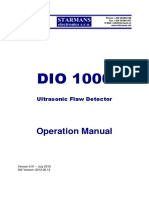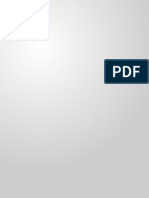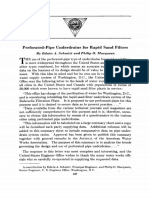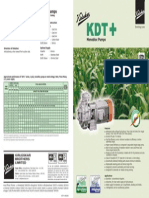A048 AGF Manual
A048 AGF Manual
Uploaded by
CastoriadisCopyright:
Available Formats
A048 AGF Manual
A048 AGF Manual
Uploaded by
CastoriadisOriginal Description:
Copyright
Available Formats
Share this document
Did you find this document useful?
Is this content inappropriate?
Copyright:
Available Formats
A048 AGF Manual
A048 AGF Manual
Uploaded by
CastoriadisCopyright:
Available Formats
FILTRATION
AGF SAND MEDIA
FILTERS
OPERATION, INSTALLATION & MAINTENANCE GUIDE
2 AGF SAND MEDIA FILTER OPERATIONS, INSTALLATION & MAINTENANCE GUIDE
TABLE OF CONTENTS
Features & Applications......................................................................................................4
Specifications........................................................................................................................4
System Operation..................................................................................................................6
Installation & Assembly
Filter Pad................................................................................................................7
Installation.............................................................................................................7
Grooved Victaulic Coupling Assembly.............................................................7
Backflush Valve Assembly.................................................................................8
Manifold Assembly..............................................................................................8
Air Vent and Quick Reacting Relief Valve Assembly.....................................8
Backflush Manifold Assembly...........................................................................8
Backflush Controller and Hydraulic Command Assembly...........................9
Backflush Controller Electrical Wire Hookup................................................9
Solenoid Electrical Wire Hookup......................................................................9
Adding the Sand or Media................................................................................................10
Backflush Operation
Backflush Principles..........................................................................................10
Pressure Differential Switch (PDS)................................................................10
Time Settings.......................................................................................................11
Manual Backflushing........................................................................................11
Backflush Pressure...........................................................................................11
Backflush Restriction Valve Adjustments.....................................................11
System Start-up
Pre-Start...............................................................................................................12
Start-up................................................................................................................12
System Maintenance
Monthly and Seasonal Maintenance.............................................................12
Replacing Media (Sand)...................................................................................13
Troubleshooting...................................................................................................................14
Replacement Parts.............................................................................................................15
AGF SAND MEDIA FILTER OPERATIONS, INSTALLATION & MAINTENANCE GUIDE 3
FEATURES & APPLICATIONS
PRODUCT FEATURES
Integral polyethylene liner and high-strength plastic underdrain are resistant to common agricultural chemicals.
Large access ports allow for easy inspection of media beds.
Standard with corrosion-proof polypropylene manifolds.
Proven backflush valves combined with an integral tank venting system provide smooth system start-up and
backflushing.
Designed with 55 mushrooms providing efficient backflushing - lifting and flushing the sand bed evenly.
Modular construction for easy servicing as all components can be removed and easily replaced using common tools.
Light-weight composite construction allows for easy transportation without the use of expensive installation equipment
and labor.
Adjustable leg height for easy retrofit to existing manifold systems.
APPLICATIONS
Filtering surface water with high concentration of algae and other organic material.
Filtering well water to remove sand particles and undissolved iron.
SPECIFICATIONS
SPECIFICATIONS
Maximum Flow Rates: Good water quality - 25 GPM/sq. ft.
AGF HEADLOSS
Dirty water - 20 GPM/sq. ft. (for single filter in filtration cycle)
10
Minimum Operating Pressure for Filtration: 15 psi
PRESSURE PER SQUARE INCH
Minimum Operating Pressure for Backflushing: 30 psi downstream of 8
the filter for proper cleaning 6
Maximum Operating Pressure: 85 psi
4
Filter Tank Size: 48
2
Media Required: 1300 lbs. per filter tank
Manifolds: Polypropylene 100 200 300 400 500 600
Quick Reacting Relief Valve installed on the Inlet Manifold is GALLONS PER MINUTE
recommended.
4 AGF SAND MEDIA FILTER OPERATIONS, INSTALLATION & MAINTENANCE GUIDE
SPECIFICATIONS
VOLUMES AT RATED FLOW
MANIFOLD FILTRATION DIRTY WATER AVERAGE WATER CLEAN WATER WEIGHT MEDIA
FILTERS
SIZE AREA (ft2) 14-18 GPM/ft2 18-28 GPM/ft2 23-28 GPM/ft2 (FILTERS ONLY) REQUIRED
1 N/A 12.5 175-225 225-290 290-350 265 LBS. 1,300 LBS.
2 6" 25.0 350-450 450-575 575-700 530 LBS. 2,600 LBS.
3 6" 35.7 525-675 675-860 860-1,050 795 LBS. 3,900 LBS.
4 8" 50.0 700-900 900-1,150 1,150-1,400 1,060 LBS. 5,200 LBS.
4 (TEE) T6" x 10" x 6" 50.0 700-900 900-1,150 1,150-1,400 1,060 LBS. 5,200 LBS.
5 (TEE) T6" x 10" x 6" 62.5 875-1,125 1,125-1,440 1,440-1,750 1,325 LBS. 6,500 LBS.
6 (TEE) T6" x 10" x 6" 75.0 1,050-1,350 1,350-1,725 1,725-2,100 1,590 LBS. 7,800 LBS.
2" AIR VENT C B
INLET MANIFOLD
A
1" COMMAND FILTER
K
4 BACKFLUSH VALVE
DRAIN
G
OUTLET
OUTLET
MANIFOLD
E
L
H D
AGF SYSTEM DIMENSIONS
4 TANKS 5 TANKS 6 TANKS
KEY DIMENSION EXPLANATION 2 TANKS 3 TANKS 4 TANKS
(TEE) (TEE) (TEE)
A INLET/OUTLET DIAMETER 6" 6" 8" 10" 10" 10"
B TANK DISTANCE 52" 52" 52" 52" 52" 52"
C INLET/OUTLET REFERENCE 26" 26" 26" 26" 26" 26"
D LENGTH 101" 153" 205" 224" 276" 328"
E OUTLET HEIGHT 12 1/2" 12 1/2" 11 1/2" 12 1/2" 12 1/2" 12 1/2"
G INLET HEIGHT 78" 78" 79" 78" 78" 78"
H WIDTH 49" 49" 49" 49" 49" 49"
J DISTANCE BETWEEN INLET/OUTLET 104" 156" 208" - - -
K BACKWASH LINE DIAMETER 4" 4" 4" 4" 4" 4"
L LENGTH OF 6" X 10" X 6" TEE - - 82 1/2" 66" 19" 19"
AGF SAND MEDIA FILTER OPERATIONS, INSTALLATION & MAINTENANCE GUIDE 5
SYSTEM OPERATION
Inlet
FILTRATION MODE Backflush
During filtration, unfiltered water enters the AGF filter system Port Backflush
via the inlet manifold and the filtered water exits the system Valve
to the field through the outlet manifold. During filtration,
the inlet ports are open and the backflush ports are closed.
Water flows from the top to bottom across the sand layer.
Outlet
Inlet
Backflush
BACKFLUSH MODE Port Backflush
During backflush, the inlet port closes and the backflush Valve
port opens. This reverses the flow of water in the filter. Clean
water from the other filters now flows into the filter from the
bottom, lifting the sand media and freeing the accumulated
debris. The debris will be flushed out the top of the filter
through the backflush valve into the backflush manifold.
Only one filter should backflush at a time. The backflush
flow depends on the pressure differential between the outlet
manifold and the backflush manifold.
From Outlet
Manifold
6 AGF SAND MEDIA FILTER OPERATIONS, INSTALLATION & MAINTENANCE GUIDE
INSTALLATION & ASSEMBLY
FILTER PAD
Pour a concrete level slab 4 thick with a 6 by 6 footing.
Compact the soil all around the filter station pad to prevent erosion.
It is recommended that the pad dimensions exceed the filter battery
dimensions by at least 1 1/2 feet on all sides.
INSTALLATION
Bring the filter as close to the cement pad as possible. 17
Remove the plastic straps and the cover wrapping.
Set the 3 legs aside. Remove the styrofoam packaging and lay it next to FIGURE 1 - Height above ground level
the tank.
Lay the tank on its side on top of the packing material.
Insert the unattached legs as follows:
- Determine the correct filter height. Note: With the legs inserted as
provided, the outlet will be approximately 17 above ground level. If the
battery height needs to be lower, for example retrofitting to an existing
system, the legs may be cut to size. See Figure 1.
CAUTION: Once fully inserted, the legs cannot be removed. Carefully check
measurements before proceeding.
- Make all cuts as square as possible and verify that the three legs are
the same length after cutting.
- Insert the legs into the leg housing.
- Place a piece of wood over the leg base cap and strike the wood with
a hammer until the leg is fully seated in the housing. FIGURE 2 - Assembling the legs
See Figure 2.
When placing the filter upright, make sure that two legs are resting firmly
on the ground. Two people are recommended for this process.
Orient the AGF filter tanks on the foundation by facing tank access ports
in the same direction. See Figure 3.
Pump inlet should be 3 to 4 below the surface and a minimum of 2.5 off
the bottom to prevent intake of excess dirt when pumping from a ditch or
reservoir.
GROOVED VICTAULIC COUPLING ASSEMBLY
AGF filters are assembled with grooved victaulic couplings connecting
FIGURE 3 - Filter tank positioning
the components.
Grooved victaulic coupling assembly:
- Remove bolts from coupling and place the rubber gasket completely
onto one of the grooved components to be assembled. A soap or
Rubber Gasket
gasket lube can be used to lubricate the gasket. Adjoin the two
grooved components and slide the rubber gasket back so that it is
centered between the two grooved fittings. Place the clamps around
the gasket and tighten bolts. Install all other components before
tightening the bolts. See Figure 4.
FIGURE 4 - Gasket position during
assembly
AGF SAND MEDIA FILTER OPERATIONS, INSTALLATION & MAINTENANCE GUIDE 7
INSTALLATION & ASSEMBLY
BACKFLUSH VALVE ASSEMBLY
Install one backflush valve on each AGF filter tank.
Verify that the flow arrow on the backflush valve points downward towards
the filter tank. See Figure 5.
Do not tighten the couplings at this time. AGF Tank
MANIFOLD ASSEMBLY
Align and attach the inlet manifold to the backflush valves with the grooved
victaulic couplings.
Align and attach the outlet manifold to the filter tank outlet with the grooved FIGURE 5 - Backflush valve installation
victaulic couplings.
Tighten only enough to hold the manifolds in place - do not overtighten.
AIR VENT AND QUICK REACTING RELIEF VALVE ASSEMBLY
Install the 2 Combination Air Vent onto the inlet manifold. See Figure 6.
It is highly recommended to install a 2 Quick Reacting Relief Valve to protect
the filter station from high pressure surges. Must purchase separately from
distributor.
Install the 2 Quick Reacting Relief Valve to the inlet manifold using a 2
Threaded nipple. See Figure 6.
Tighten all grooved victaulic couplings when these filter components are
installed.
FIGURE 6 - Air Vent and Quick
Use of a 2 Quick Reacting Relief Valve with Netafim inlet/outlet manifolds Reacting Relief Valve assembly
extends warranty from 2 years to 5 years
BACKFLUSH MANIFOLD ASSEMBLY
Parts described in this section are not supplied by Netafim - must be purchased separately from distributor.
The minimum recommended size for the backflush manifold is 4. PVC is generally used to construct this manifold.
The backflush water should be discharged through an open pipe (to atmosphere) and not connected to any pressurized
line. It is helpful to have the end of the discharge line accessible. A clear PVC sight tube to verify backflush is highly
recommended. The backflush manifold should not be run to a location that is more than 10 higher than the backflush
valve and should not exceed 100 in length. For exceptions, evaluate conditions and contact Netafim.
Install a 2 Guardian Air/Vacuum Air Vent
in the Backflush manifold after the last AGF
filter and upstream of the restriction valve.
A backflush restriction valve must be
installed in the backflush manifold for
reliable backflush function. This valve
should be installed close the filters. Gate
or globe valves can be used as a backflush
restriction valve. Adjustment of this valve
is explained in Backflush Restriction Valve
Adjustment section, page 9.
FIGURE 7 - Backflush manifold assembly
8 AGF SAND MEDIA FILTER OPERATIONS, INSTALLATION & MAINTENANCE GUIDE
INSTALLATION & ASSEMBLY
BACKFLUSH CONTROLLER AND HYDRAULIC
COMMAND SYSTEM ASSEMBLY
Follow the instructions for the installation of the backflush
controller from the manufacturer.
The bottom of the backflush controller accepts two 1/8 x 8mm
fittings for the Pressure Differential Switch marked HI (center)
and LO.
Attach the hydraulic command disc filter and pressure gauge
assembly to the inlet manifold. A 1 Disc Filter is used and FIGURE 8 - Hydraulic command
requires a connection fitting. assembly
Attach the pressure gauge assembly to the outlet manifold.
Connect hydraulic control tubing from the HI Port of the Pressure SOLENOID
Differential Switch on the Backflush Controller to the tee fitting
Vent
labeled HP. This connects to the solenoid on the first AGF filter
and continues until all the solenoids are connected. The last
solenoid will have an elbow fitting. See Figure 8 and Figure 9.
Connect hydraulic control tubing from LO port of the Pressure
Differential Switch on the Backflush Controller labeled LP to the
fitting of the pressure gauge installed in the outlet manifold. From Control
1 2
To Bonnet of
Filter Port 1 Port 2 Backflush Valve
BACKFLUSH CONTROLLER ELECTRICAL WIRE FIGURE 9 - Solenoid hydraulic
connections
HOOK-UP
Use 1/2 conduit and 16 gauge wire or larger from the backflush
controller to the solenoids. AC POWER WIRING
C is common to all solenoids 24VAC or 12VDC. For the 12VDCL 24 VAC
C 8 7 6 5 4 3 2 1 A M
(latching), use positive or red lead.
Orange
Yellow
Yellow
Master
Relay Valve
115 VAC 115 or 230 Solenoid on Tanks
M is master valve - used with Pressure Sustaining Normally Open OR
230 VAC
50/60 Hz
Transformer Solenoid Common
or Electric valves to control the downstream flow. See Figure 10. 12 VDC POWER WIRING
Terminals 1-8 for each solenoid are the hot lead. Do not use transformer and wire + 12 VDC to first two terminals. Do not use third terminal.
C 8 7 6 5 4 3 2 1 A M
12 VDC
Seal the wire access holes to the controller.
OPEN CONTACT
From
Solar
+ Panel
Relay
Master
Valve
12 VDC Solenoid on Tanks
Battery
SOLENOID ELECTRICAL WIRE HOOK-UP Common
Red lead from latching solenoid on DCL models.
Loosen bolt (A). Pull hub assembly off. See Figure 11. FIGURE 10 - Backflush controller wiring
Remove (D) and push terminal (C) out with a screwdriver through
the access port.
A
Connect wires to 1 and 2 of the terminal block (C). For DCL B
solenoids, connect negative (black) to 1. If no conduit is used,
first put the wires through the 1/2 x 1/4 reducer. 2
C
Reassemble the hub and seal on the access port (D).
FIGURE 11 - Solenoid electrical wiring
AGF SAND MEDIA FILTER OPERATIONS, INSTALLATION & MAINTENANCE GUIDE 9
ADDING THE SAND OR MEDIA
Remove the top access cover of the AGF filter tank
and before adding any media to the filter, inspect SILICA SAND DATA
MEDIA MESH MEAN EFFECTIVE UNIFORMITY MINIMUM
the inside of the filter tank to be certain there are no TYPE RANGE SIZE (MM) COEFFICIENT BACKFLUSH FLOW
foreign objects in the tank. Check the mushroom CRUSHED SILICA 12 80-130 1.1 - 1.2 1.5 240 GPM
covers and connector pins to be sure they are all in STANDARD SAND 6/20 100-140 0.9 - 1.0 1.5 240 GPM
place and secured straight. CRUSHED SILICA 16 155-200 0.6 - 0.7 1.5 200 GPM
Fill each tank through the top access port with the U.S. SILICA 80 160-200 0.6 - 0.7 1.5 225 GPM
sand media to the level indicated on the label affixed CRUSHED SILICA 20 170-230 0.45 - 0.5 1.5 180 GPM
to the filter tank exterior.
NOTE: Use of gravel or any other material besides the recommended sand or silica media as indicated in the Silica Sand
Data Chart, voids the warranty and can cause damage to the underdrain and tank structure.
BACKFLUSH OPERATION
BACKFLUSH PRINCIPLES Inlet
During backflush, once a preset pressure differential or preset time is reached, Backflush
Port Backflush
the backflush controller will activate one solenoid (valve and filter tank) at a time Valve
to perform a backflush operation. The inlet port closes and the backflush port
opens. This reverses the flow of water in the media filter; clean water from the
other filters now flows into the filter from the bottom and through every mushroom
with equal pressure, lifting the sand media and freeing the accumulated debris.
The debris will be flushed out the top of the filter through the backflush valve into
the backflush manifold to a suitable location. Only one filter should backflush at
a time. The water which is backflushing one filter will have passed through the
other filters and thus backflushing will be done with clean filtered water.
As debris builds up in the AGF filter, a pressure loss will develop across the filter.
From Outlet
The dirtier the filter becomes, the greater the pressure loss. When the pressure Manifold
loss reaches a critical limit, the filter is dirty and in need of a backflush. Backflush
controllers will sense the pressure loss through hydraulic connections and
command a backflush sequence to begin when necessary.
It is recommended to backflush every 2-4 hours regardless of pressure loss.
PRESSURE DIFFERENTIAL SWITCH (PDS)
The PDS in the backflush controller reads the current pressure loss and has an
adjustable needle which determines the set-point for backflush cycle initiation.
FIGURE 12 - PDS
The PDS has an adjustable setting from 0 to 15 psi. See Figure 12.
The pressure differential is the combined headloss through the filter and the
valve when the sand is clean. With the filter clean and in filtration mode, read the
current pressure loss. This is the Baseline Pressure Loss for clean filters - usually
2 to 3 psi.
To establish a backflush Set Point pressure, add 5 to 7 psi to the Baseline Pressure
Loss and set the adjustable hand to this Set Point. The filter system will now enter
into a backflush cycle any time this pressure loss Set Point is reached.
BACKFLUSH
CONTROLLER
10 AGF SAND MEDIA FILTER OPERATIONS, INSTALLATION & MAINTENANCE GUIDE
BACKFLUSH OPERATION
TIME SETTINGS
The Flush Time setting determines the duration of the backflush for each filter. The recommended Flush Time setting
is 90 seconds. In low pressure applications, more time may be required. If over 90 seconds is required to make a
proper backflush, it may be that the filter is becoming excessively dirty between backflushes. When 90 seconds fails to
provide a complete backflush, decrease the pressure differential setting by 1 to 2 psi to decrease the period between
backflushing cycles. NOTE: Finer grades of sand will require longer backflushing than coarser grades.
The Dwell Time is the time period between the flushing of each filter in a given backflushing cycle. This is necessary to
let the sand settle down and for the pump to recover pressure. A recommended Dwell Time is 20 to 40 seconds.
The Periodic Flush time is the flushing interval in hours. This setting establishes a time schedule for backflushing to
ensure that a backflush takes place if there is a failure in the pressure differential switch. Typical Periodic Flush times
can be set anywhere from 2 to 4 hours depending on the water quality. To properly set the Periodic Flush time, the filter
should be observed through several backflush cycles initiated by the pressure differential switch, recording the time
between each backflush cycle. Multiply the amount of time between backflush cycles by 1.2 to get the proper Periodic
Flush time setting.
It is common for open water sources to have different quantities of debris during the irrigation
season and it is important to adjust your backflush settings in response to this change.
Solenoid Coil
MANUAL BACKFLUSHING
All backflush valves can be operated manually. A manual override knob is installed on the
base of all non-latching solenoids. See Figure 13.
During normal operation, the knob will be facing down. Turning this knob 90 degrees to Manual
the left or right will activate the solenoid and put the media filter into a backflush mode.
Auto
Backflushing should be maintained until the water becomes clear. At this point, the knob
Solenoid Base
can be returned to the auto position for normal irrigation.
FIGURE 13 - Solenoid
Backflushing normally requires 90 to 120 seconds.
manual override
BACKFLUSH PRESSURE
Filters must have both adequate pressure and water velocity for proper backflush. It is recommended that AGF filters
have a minimum of 30 psi of pressure on the downstream side during backflush.
When the system consists of only two or three filters, the water pressure must be carefully considered. Backflushing
requires that all the water flows through one filter to backflush the other filter. This can change the pressure drop
through the one filter, resulting in inadequate pressure for the other filter - especially when using a pump with a steep
characteristic curve.
For low pressure or low flows, consult an Authorized Netafim Dealer for recommendations. Generally the addition of a
Pressure Sustaining Normally Open Valve downstream of the filter station will increase backflush efficiency.
BACKFLUSH RESTRICTION VALVE ADJUSTMENTS
The backflush flow must be restricted in order to prevent the media from being washed out with the dirty water. In the
backflush mode, the media is in a turbulent suspension with the water and debris. Proper adjustment of the Backflush
Restriction Valve will allow for proper backflush flow with only a trace of media being lost through the backflush. A
small loss of media is considered optimum.
To check if media (sand) is being washed out with the backflush water, place a screen over the outlet of the backflush
manifold and examine the water for sand. Another method is cupping your hand under the backflush water as it exits
the backflush manifold and feeling for sand grittiness.
Adjust the Backflush Restriction Valve. Repeat this adjustment at normal system operation and perform an automatic
backflush by pushing the Manual Start button.
AGF SAND MEDIA FILTER OPERATIONS, INSTALLATION & MAINTENANCE GUIDE 11
SYSTEM START-UP
PRE-START
Make sure all grooved victaulic couplings and connections are tight.
Secure the top cover and tighten.
Open field valves to allow water flow from filters to field.
Open the backflush manifold throttle valve to fully open.
Check the backflush controller and solenoid operation. Solenoids will click when an electric signal is sent and the metal
screw on top of the coil becomes magnetic (test with a screwdriver- it sticks). After checking, set backflush controller
in the off position.
START-UP
Open the main valve supplying water to the filters and start the pump.
Let the downstream pressure gradually build up to 30 psi - can be checked via pressure gauge on the downstream
manifold.
Start a manual backflush using the override on the solenoid for each filter. Run backflush cycle for at least 3 minutes or
until you can see clear water coming out of the backflush manifold. Repeat for each filter.
Note: New media (sand) has contaminants and fines. After a few backflush cycles, it will be removed and the water will
become clean.
Check for any leaks and tighten the cover ports a little more if necessary.
Start automatic backflushing with the backflush controller after confirming the settings are correct.
SYSTEM MAINTENANCE
MONTHLY AND SEASONAL MAINTENANCE
Check the control filter every few weeks and clean the filter element.
Inject Chlorine upstream of the filters during and at the end of the season or as necessary to control algae and bacterial
growth.
At the beginning of the irrigation season, fill the filter with water and add Chlorine. Let stand for 30 minutes. Backflush
for 2 minutes and begin irrigation.
At the end of every irrigation season, add Chlorine to the water in the filter for 30 minutes and allow to set. Backflush for
at least 2 minutes. Drain all the water from the filter, leaving it dry and close the inlet and outlet valves.
The Chlorine injection rate in GPH is:
Strength (10% solution = 10 factor) x GPM x ppm Chlorine x 0.00006 = gallons of Chlorine per hour
Example: 10% solution x 40 GPM x 25 ppm Chlorine x 0.00006 = 0.6 GPH
Shock treatments may require 20 to 50 ppm.
Flush the entire system after the treatment as Chlorine is a dangerous chemical and all application regulations and
safety rules must be observed. Contact a qualified person for further assistance.
Recommended monthly - open upper cover and check sand level. Add media if required.
Check for external damage to the filter. Any damage to the protective coating of the filter must be repaired as soon as
possible.
At the end of the irrigation season, initiate a backflush cycle, at a minimum of 30 psi, to ensure a clean sand bed during
the off season.
12 AGF SAND MEDIA FILTER OPERATIONS, INSTALLATION & MAINTENANCE GUIDE
SYSTEM MAINTENANCE
REPLACING MEDIA (SAND)
The sand media is usually changed every 3 to 5 years depending on how much the system operates. The sand
edges become rounded and sharp edges are necessary for proper filtration.
Close all the valves and verify that no pressure remains in the filter tanks.
Open the top service cover.
Open the 3 plug on the lower cover, start the pump, and drain all the water and sand from the filter. Remove the
lower cover for faster draining. Do not use sharp tools to help remove the sand as mushrooms can be damaged.
Rinse and clean the inside of the filter tank.
Check the mushrooms.
Close the 3 plug and install the lower cover (make sure threads are free of sand).
Fill the tank with water and add the new sand media.
Open all the valves for normal operation and readjust the Backflush Restriction Valve in the backflush manifold.
See Backflush Restriction Valve Adjustments on page 9 for further instructions.
NOTE: Use of gravel or any other material besides the recommended sand or silica media as indicated in the Adding
the Sand Media Chart on page 10, voids the warranty and can cause damage to the underdrain and tank
structure. Tanks must be filled with water prior to adding recommended media. Failure to do so could damage the
internal components and void the warranty.
AGF SAND MEDIA FILTER OPERATIONS, INSTALLATION & MAINTENANCE GUIDE 13
TROUBLESHOOTING
SYMPTOM POSSIBLE CAUSES SOLUTIONS
Filter station Excessive flow During system start-up, throttle downstream flow to the designed flow rate. Use a
differential increases rate manual valve or pump control/sustaining valve.
rapidly during
operation, especially Unusual concentration Check water source quality. See an Authorized Netafim Dealer for assistance.
at start-up of contaminants
All the filters in Controller output Check that the controller is on and programmed correctly. Attempt to manually
station will not problem actuate the solenoid with the clock. The solenoids should emit a clicking noise
backflush when actuated.
Insufficient Use the manual knob on the base of the solenoid to backflush one tank. Note the
downstream pressure downstream pressure reading. If the pressure falls below 20 psi, it may be
for backflush necessary to throttle the field valves to build up sufficient backflush pressure.
Hydraulic command Check to be sure the isolation valve is in the on position. Remove one of the
system failure hydraulic tubes leading to the solenoids and verify that pressurized water is
available. Inspect the hydraulic command filter for contamination.
Filter station Gauge error Check gauge differential on manifolds against the differential gauge in the controller.
differential If there is a discrepancy, check readings with a new gauge.
remains high after
backflush Insufficient backflush Verify that the downstream pressure during backflush is at least 20 psi. If it is not, it
pressure may be necessary to throttle a valve downstream of the filter station to develop
sufficient backflush pressure.
Insufficient backflush Check the Backflush Restriction Valve setting. Adjust according to the procedures
flow outlined in the Backflush Restriction Valve Adjustments section.
Excessive Open the access cover and inspect the media bed after a backflush. Verify that the
contamination of media sand level is correct and that there is not an excessive amount of debris in the sand.
Verify that the backflush manifold line meets the size requirements outlined in the
Backflush Manifold Assembly section.
Leaking around Pinched gasket Remove couplings and inspect gasket. Apply gasket lube to prevent pinching.
grooved couplings
Torn or cracked gasket Remove torn gasket and replace.
Components out of Remove couplings and gaskets and inspect grooved fittings. Fittings should join
alignment squarely with no major gaps.
Leaking around Debris between gasket Remove gasket and inspect gasket and seat for any debris.
access ports or and seat
top access vent
Torn or cracked gasket Inspect gasket for cracking or other damage - replace if necessary.
Cracked access cover Inspect access cover for cracks or damage - replace if cracked or defective.
Torn or cracked O-ring Remove top access cover and inspect vent O-ring for damage - replace if
necessary.
Damaged vent Inspect vent for possible cracks - replace if necessary.
One or several Controller output Check for correct controller output with multi-tester or switch solenoid wires with
filters will not problem another station to check for output signal.
backflush
Solenoid wiring is Use ohmmeter to verify that wiring is intact. Attempt to manually activate the
defective solenoid with the knob on the base.
On filters with manual Verify that selector valve knob is pointed towards the solenoid.
selector valve - valve
setting incorrect
Solenoids clogged or Open solenoids and inspect internal ports for evidence of clogging.
damaged Open carefully to avoid losing the internal spring-loaded plunger.
14 AGF SAND MEDIA FILTER OPERATIONS, INSTALLATION & MAINTENANCE GUIDE
REPLACEMENT PARTS
Key Item Number Model Number Description
1 70620-008650 Locking Nut
27AP28200012
2 70620-009300 Inlet
27AP28200014
17
3 70620-007070 Seal
27AP50060482
18
4 70620-009250 Distribution Plate
27AP28200018 13
5 70620-008660 Upper Sealing Nut
27AP28200010 32
6 70620-009000 Pin
27AP28200028 1 16
7 70620-009400 Mushroom (55 per tank)
27AP28200030 2 15
8 70620-009270 Upper Diffuser Complex
27AP22480052 21 34
With mushrooms 35
3 20
9 70620-008850 27AP28200026 End Cup 22
10 70620-009260 27AP28200020 Drum 4
11 70620-009280 27AP22480054 Lower Diffuser Complex
with Mushrooms 19 5
12 70620-008500 27AP28200016 Outlet 7 6 27
13 70620-009500 27AP50050548 Cover Seal 8 11
10
14 70620-008780 27AP28200324 Lower Cover
15 70620-003975 25AP50032235 O-Ring 2-235 14 23
9
16 70620-008820 27AP28200340 Lower Plug 15 10 24
33
17 70620-008600 27AP28200036 Bridge
70620-008700 27AP28200038 Tightening Screw 16 25
18 27
13
19 70620-009100 27AP28200011 Lower Plug Assembly 12 26
20 70620-008800 27AP28200322 Upper Cover
32 3 28
21 70620-009590 27AP28200046 Vacuum Release 17
22 70620-007060 27AP50032310 O-Ring 2-310 1
30 18
23 - 27AP50403830 W 3/8 x 1 1/4 Screw 29
24 - 27AP50760248 Handle 31
25 70620-009570 27AP28200040 Leg Housing
26 - 27AP50403840 W 3/8 x 1 1/2 Screw
27 - 27AP50409138 3/8 Washer
28 70620-009600 27AP50501400 Leg
29 70620-008900 27AP28200050 Base Cup
30 70600-009460 27AP50760022 Lower Drain Plug Tool
31 70600-009450 27AP50760021 Locking Nut Wrench
32 70620-008620 27AP22480056 Bridge Complete
33 70620-008760 27AP22480032 AGF Lower Cover Complete 36 37 38
34 70620-008750 27AP22480022 AGF Upper Cover Complete
35 70620-008770 27AP50400018 Spring
36 70040-003100 44VIC04 Victaulic Coupling
37 40001-000381 15CONT8C10 8mm Control Tubing (10 coil)
38 70641-001600 25A47-120 1 Manual Disc Filter
39 70640-015000 27AGF48 48 AGF Tank Only
40 70800-003260 61BBC-024 24VAC Brass Solenoid
39 40 41
41 71000-013430 61BFG4GPB 4 Series 350 Backflush Valve
42 70561-001700 65ARIB2PP 2 Combination Air Vent
43 00110-001790 6809020-100 Pressure Gauge 0-100 psi
44 77350-017720 44NIPVS04 PVC Nipple 4 Slip x Groove
42 43 44
AGF SAND MEDIA FILTER OPERATIONS, INSTALLATION & MAINTENANCE GUIDE 15
NETAFIM USA
5470 E. Home Ave.
Fresno, CA 93727
CS 888 638 2346
www.netafimusa.com
A048 6/13
You might also like
- Ansul Bladder Tank Fill and Maintenance Manual PDFDocument17 pagesAnsul Bladder Tank Fill and Maintenance Manual PDFCastoriadis0% (2)
- Idromar Operational Manual MC5sDocument45 pagesIdromar Operational Manual MC5sFERDINAUTIC SL Servicios nauticosNo ratings yet
- Bba de Lodos Dampener - Instruction - Manual - Rev - DDocument10 pagesBba de Lodos Dampener - Instruction - Manual - Rev - Desteban monterrosa lopez100% (4)
- Product Sheet Damen Stan Lander 5612 12 2016Document2 pagesProduct Sheet Damen Stan Lander 5612 12 2016Григорий Шарун100% (1)
- TC1001-D Annular BOP Replacement Part CatalogDocument24 pagesTC1001-D Annular BOP Replacement Part CatalogFam Escalante OnofreNo ratings yet
- Permintaan Sparepart Wko-036Document3 pagesPermintaan Sparepart Wko-036ary fauzi rahmanNo ratings yet
- Tank Operating Manual Rev 3 PDFDocument54 pagesTank Operating Manual Rev 3 PDFCastoriadisNo ratings yet
- Daikin - ChillerDocument55 pagesDaikin - ChillerFerLeyes89% (9)
- Filtro XPLORDocument28 pagesFiltro XPLORHéctor RomeroNo ratings yet
- ITT N-Series Pump CurveDocument8 pagesITT N-Series Pump CurvePumpdesignNo ratings yet
- Gold MiningDocument13 pagesGold MiningMinh HòaNo ratings yet
- Kleenoil India Catalogue 2024Document10 pagesKleenoil India Catalogue 2024Creation EngineeringNo ratings yet
- Series5000 DresserDocument8 pagesSeries5000 Dresser2212212028 TRI YOGOWIBOWONo ratings yet
- SPH FILTER Air-1Document8 pagesSPH FILTER Air-1Anugrah Mika UtamaNo ratings yet
- E-Catalogue: Abrasive Vacuum Recovery MachineDocument4 pagesE-Catalogue: Abrasive Vacuum Recovery MachinetsaipeterNo ratings yet
- CX SeriesDocument2 pagesCX Seriesaaron mufukNo ratings yet
- PermaCylDocument2 pagesPermaCylJosePsdNo ratings yet
- Pump Catalogue HYC600HCDocument28 pagesPump Catalogue HYC600HCNick JohnsonnNo ratings yet
- SDB Series Blower Purge Desiccant Dryers 1200-12000 SCFMDocument4 pagesSDB Series Blower Purge Desiccant Dryers 1200-12000 SCFMramiro alvarezNo ratings yet
- Caterpillar Performance Handbook 49 62020 Partie86Document4 pagesCaterpillar Performance Handbook 49 62020 Partie86ali alilouNo ratings yet
- BX Series Hydraulic Breaker Spec Sheet EnglishDocument2 pagesBX Series Hydraulic Breaker Spec Sheet EnglishAloysius GlassNo ratings yet
- BX SeriesDocument2 pagesBX Seriesaaron mufukNo ratings yet
- 01 Pool FiltrationDocument34 pages01 Pool FiltrationFor AccounNo ratings yet
- Hangcha A Series 1-5t Electrical Four-Wheel Forklift Truck Service Manual 2019.08Document47 pagesHangcha A Series 1-5t Electrical Four-Wheel Forklift Truck Service Manual 2019.08kirk sutherlandNo ratings yet
- Max Flow: 100 GPM (379 LPM) : SP80/90 Spin-On Filters Working Pressures To: Rated Static Burst To: Flow Range ToDocument4 pagesMax Flow: 100 GPM (379 LPM) : SP80/90 Spin-On Filters Working Pressures To: Rated Static Burst To: Flow Range Tofrancis_15inNo ratings yet
- Water Tank 20 KL Spec & Drawing FMX 6x4Document3 pagesWater Tank 20 KL Spec & Drawing FMX 6x4Hamdan MaulanaNo ratings yet
- Colector Polvo AIR BOSSDocument2 pagesColector Polvo AIR BOSScarlos.castillo.ing.1No ratings yet
- Catalogo DRAGFLOW - GUADocument28 pagesCatalogo DRAGFLOW - GUAcarlosNo ratings yet
- Sand Filters Datasheet PDFDocument2 pagesSand Filters Datasheet PDFJamesStenhouseNo ratings yet
- Product Sheet Damen Stan Lander 5612-12-2016Document2 pagesProduct Sheet Damen Stan Lander 5612-12-2016Jhon GreigNo ratings yet
- Alliance UW UC UF SpecificationsDocument4 pagesAlliance UW UC UF Specificationsmairimsp2003No ratings yet
- KATALOG Fertigation 2010 PDFDocument44 pagesKATALOG Fertigation 2010 PDFsanitermNo ratings yet
- Comi Condor Peeler Centrifuge (Partner)Document2 pagesComi Condor Peeler Centrifuge (Partner)helenekajayantiNo ratings yet
- New FG Filter Brochure 2021Document2 pagesNew FG Filter Brochure 2021Lazar PetkovicNo ratings yet
- Twin Tank Water SoftenerDocument2 pagesTwin Tank Water SoftenerCHOUKRI KamalNo ratings yet
- Pump SpecificationsDocument2 pagesPump Specificationsstranger252LavaNo ratings yet
- Fluid Filter Hydac (328 Pages)Document328 pagesFluid Filter Hydac (328 Pages)matjidiNo ratings yet
- 06 (1) Vol de Ran MedDocument7 pages06 (1) Vol de Ran MedLhau009No ratings yet
- Ideal DAF: Dissolved Air FlotationDocument4 pagesIdeal DAF: Dissolved Air FlotationblondtumbalaNo ratings yet
- Gear Pump Division: Rotary Flow Dividers and Pressure IntensifiersDocument33 pagesGear Pump Division: Rotary Flow Dividers and Pressure IntensifiersMehdi MansourianNo ratings yet
- Vacuum Pumps - CatalogDocument8 pagesVacuum Pumps - Catalogdéborah_rosalesNo ratings yet
- Techno AppliancesDocument11 pagesTechno AppliancesJenel Ionovici100% (1)
- HP Series 1604Document2 pagesHP Series 1604DrZEIDINo ratings yet
- 08-2012 Flow Dividers and Pressure IntensifiersDocument33 pages08-2012 Flow Dividers and Pressure IntensifiersTulio Andres CoyNo ratings yet
- Catalogo Hanil 2018 PDFDocument110 pagesCatalogo Hanil 2018 PDFCESPI-PERUNo ratings yet
- Clark - Rubber - Filtrite - MF - Media - CF Cartridge - Filter - DatasheetDocument1 pageClark - Rubber - Filtrite - MF - Media - CF Cartridge - Filter - DatasheetDaniel LyndersNo ratings yet
- English SuperflowDocument2 pagesEnglish Superflowjhumar.eightspazioNo ratings yet
- Tenaga: NO Material A. PenghantarDocument8 pagesTenaga: NO Material A. PenghantarAzizahNo ratings yet
- Model THE: Horizontal Drilling Duty PumpDocument2 pagesModel THE: Horizontal Drilling Duty PumpzhujianglongNo ratings yet
- BrochureDocument7 pagesBrochureBruce BlakeNo ratings yet
- Arkal Leader Twin 3Document2 pagesArkal Leader Twin 3Ame Mena SantosNo ratings yet
- Rotating Control Device: SperrydrillingservicesDocument4 pagesRotating Control Device: SperrydrillingservicesSlim.B100% (2)
- Woma Uhp PumpDocument28 pagesWoma Uhp PumpJuliyanto STNo ratings yet
- Cat 320cl SpecDocument5 pagesCat 320cl Specabdeljalil.ufoNo ratings yet
- Shop VacDocument4 pagesShop Vacee1993No ratings yet
- hanil_catalog_2019Document110 pageshanil_catalog_2019ariel.jpr89No ratings yet
- TrainingDocument96 pagesTrainingMilind DaroleNo ratings yet
- Sección 1 Especificación PV271-275Document1 pageSección 1 Especificación PV271-275Luis RuizNo ratings yet
- RotameterDocument2 pagesRotameterJove MultisystemsNo ratings yet
- Aerox 400SeriesBi Fold Brochure SheetV2 004 (2)Document4 pagesAerox 400SeriesBi Fold Brochure SheetV2 004 (2)mehdi fathalizadehNo ratings yet
- Chiller SHDocument2 pagesChiller SHMohammad LabinNo ratings yet
- Rotameterw FiltravDocument2 pagesRotameterw FiltravJohn AdewaleNo ratings yet
- LF 60 Lat-August2015Document25 pagesLF 60 Lat-August2015Rauf GebreelNo ratings yet
- Kao R.stresses in Spherica - mar.1973.JSRDocument4 pagesKao R.stresses in Spherica - mar.1973.JSRCastoriadisNo ratings yet
- FRP Tanks: Case HistoryDocument2 pagesFRP Tanks: Case HistoryCastoriadisNo ratings yet
- EPOCH4manual PDFDocument164 pagesEPOCH4manual PDFCastoriadisNo ratings yet
- Norton Abbrasives CatalogDocument212 pagesNorton Abbrasives CatalogCastoriadisNo ratings yet
- Riveted Joints ASME IDocument7 pagesRiveted Joints ASME ICastoriadisNo ratings yet
- Novatek Metermatic Water Softener 51877 EnglishDocument12 pagesNovatek Metermatic Water Softener 51877 EnglishCastoriadisNo ratings yet
- Kunkle300 PDFDocument6 pagesKunkle300 PDFCastoriadisNo ratings yet
- Astm A285 Grade CDocument3 pagesAstm A285 Grade CCastoriadisNo ratings yet
- By Authority of Legally Binding Document: The United States of AmericaDocument5 pagesBy Authority of Legally Binding Document: The United States of AmericaCastoriadisNo ratings yet
- 138CurvedThicknessBlocks797 PDFDocument3 pages138CurvedThicknessBlocks797 PDFCastoriadisNo ratings yet
- Characterization of METHOCEL Cellulose Ethers by Aqueous SEC With Multiple DetectorsDocument11 pagesCharacterization of METHOCEL Cellulose Ethers by Aqueous SEC With Multiple DetectorsCastoriadisNo ratings yet
- Copia de Hemispherical Head Design ToolDocument1 pageCopia de Hemispherical Head Design ToolCastoriadisNo ratings yet
- Dio 1000 v5.01x en FullDocument102 pagesDio 1000 v5.01x en FullCastoriadisNo ratings yet
- Tilaa Asme BPVC 2015: ASME Boiler & Pressure Vessel Code 2015Document2 pagesTilaa Asme BPVC 2015: ASME Boiler & Pressure Vessel Code 2015CastoriadisNo ratings yet
- 2ND CotDocument11 pages2ND CotRebie Faith MoranteNo ratings yet
- Kerr Hall BuildingDocument7 pagesKerr Hall BuildingRaunak TimilsinaNo ratings yet
- Research Memorial-ParkDocument30 pagesResearch Memorial-ParkBeiya Mae100% (1)
- Kinds of Water Treatment: (Old Technology)Document8 pagesKinds of Water Treatment: (Old Technology)Allan DeGuzman Dela VegaNo ratings yet
- Price ListDocument17 pagesPrice ListAvijitSinharoyNo ratings yet
- Tarbela DamDocument10 pagesTarbela DamTahir MubeenNo ratings yet
- RRLDocument19 pagesRRLZac IriberriNo ratings yet
- SR626 Operation Maintenance Sustainable Drainage SystemsDocument92 pagesSR626 Operation Maintenance Sustainable Drainage SystemsJEAN DE DIEU MUVARANo ratings yet
- Beach Wells For Large Scale RO Plants-The Sur Oman Case StudyDocument14 pagesBeach Wells For Large Scale RO Plants-The Sur Oman Case Studyengrirfan_97No ratings yet
- Ecotec Installation and Servicing1Document64 pagesEcotec Installation and Servicing1Paun MihaiNo ratings yet
- Level 2 m200 Pahu Qa-Qc ChecksDocument10 pagesLevel 2 m200 Pahu Qa-Qc ChecksAnurag KumbhareNo ratings yet
- Intership Report 2023 1Document51 pagesIntership Report 2023 1Jyotirmoy MahataNo ratings yet
- Pumps CatalogueDocument16 pagesPumps CatalogueAzhar MandhraNo ratings yet
- BOQ Boutique FinalDocument3 pagesBOQ Boutique FinalJayr FranciscoNo ratings yet
- Is Kalabagh Dam Really Inevitable by M. Idris Rajput - Dawn, 17!04!2006Document5 pagesIs Kalabagh Dam Really Inevitable by M. Idris Rajput - Dawn, 17!04!2006Shahid Ali LeghariNo ratings yet
- Stanley Pressure Washer Owner's ManualDocument17 pagesStanley Pressure Washer Owner's Manualrtech01No ratings yet
- Water Balance and Water Conservation in Thermal Power StationsDocument6 pagesWater Balance and Water Conservation in Thermal Power StationsSoumya MohantyNo ratings yet
- DO 028 s2018Document8 pagesDO 028 s2018Anthony TangNo ratings yet
- REMMAN Raised The Defense That He Adopted Measures To Contain The Waste Water Coming From Its Piggery To Prevent Any Damage To The Adjoining EstatesDocument6 pagesREMMAN Raised The Defense That He Adopted Measures To Contain The Waste Water Coming From Its Piggery To Prevent Any Damage To The Adjoining EstatesJoshua ParilNo ratings yet
- Method Statement For Domestic Cold Water SystemDocument17 pagesMethod Statement For Domestic Cold Water SystemEric CheeNo ratings yet
- Universal State Plumbing CodeDocument118 pagesUniversal State Plumbing CodecruzserNo ratings yet
- Khalid LiteratureReview 2019Document4 pagesKhalid LiteratureReview 2019Emily ChinyereNo ratings yet
- Water AssignmentDocument3 pagesWater Assignmentapi-239344986100% (1)
- Perforated Pipe Underdrains For Rapid Sand FiltersDocument19 pagesPerforated Pipe Underdrains For Rapid Sand Filters305773253No ratings yet
- CV CaiDocument5 pagesCV Caiمهندس ابينNo ratings yet
- KDTDocument1 pageKDTapandey070273No ratings yet
- Case Study On The Application of A Proper PlumbingDocument25 pagesCase Study On The Application of A Proper PlumbingJeremie SaragaNo ratings yet
- DFR For Air-Conditioning at Kp-4Document23 pagesDFR For Air-Conditioning at Kp-4Abhinav TewariNo ratings yet






















